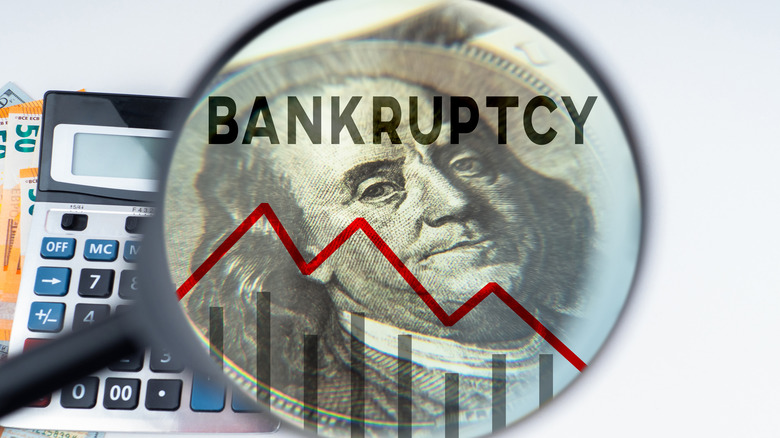What Happened To Columbia House?
Monthly subscription services are common these days, but if you're old enough, you'll remember Columbia House, the monthly subscription service that offered consumers an amazing bargain of anywhere between eight to 12 records for a penny. Of course, there's more to the deal, which includes buying a certain amount of CDs at regular prices within a certain period (via Insider).
Columbia House began as Columbia Record Club in 1955, and it was an experiment to get a feel for how the public would respond to marketing music through direct mail (via Funding Universe). The idea was to give away one record to anyone who chose to become a member of the club, and they then committed to buying a certain amount of records in the future. The idea was a hit, and by the end of 1955, the company reportedly had 128,000 members. Seven years later, Columbia House delivered some 7 million records to members, and by 1960, it accounted for 10% of all sales spent on recorded music.
It continued to grow in the '90s
Columbia House's popularity continued to expand in the coming years, and in 1975, the company boasted more than 3 million members. In the '80s, the company created the Canadian Music Club and the CBS Video Library, which expanded their library to include videos of television shows and eventually accounted for half of their sales, per Funding Universe.
By 1990, Columbia House shipped more than one billion records to consumers. By the end of the decade, however, the company began to experience a decline in sales. Part of this was due to competitors, including Amazon. In 1999, Columbia House announced a merger with online music seller CDNow (via Funding Universe), but that plan was axed a few years later, with both companies taking a financial hit (per CNET). Over the years, Columbia House had several owners, including Sony, Blackstone Group, JMCK Corp., and Pride Tree Holdings (via The Hollywood Reporter).
Columbia House filed for bankruptcy in 2015
Due to Columbia House's ability to adapt to the changing technology, it was able to continue to generate new customers — for a time. From 8-tracks to cassettes and eventually CDs, the company topped $1.4 billion in revenue by 1996 (via The Hollywood Reporter). But it was unable to compete with streaming music, and in 2010 it ceased selling music altogether and turned its focus to DVDs.
Of course, this change meant that Columbia House began losing even more money as it attempted to rebrand itself as a DVD club that year. Five years later in 2015, then-owner Filmed Entertainment filed for Chapter 11 bankruptcy protection. Filmed Entertainment explained to NBC News that the loss of revenue was "driven by the advent of digital media and resulting declines in the recorded music business." That said, Columbia House has managed to hang around, offering members deals on movies.
How did it profit?
So how did Columbia House make money giving away so many records? The answer is it had a few tricks up its sleeve. One had to do with the quality of the records. New York University music business professor Larry Miller tells Business Insider that record clubs like Columbia House manufactured inferior recordings for around $1.50 each. The company made about $5 for every record they sold — including the free records. He explains that shipping and handling costs were central to the company's success, and it gave them "plenty of margin" to operate on.
Another factor that contributed to Columbia House's growth was that the company didn't pay artists much — if any — in the form of royalties. Forbes reports that royalties aren't paid on "free" records, so that means artists were not compensated for any of the records that were given away.
Columbia House capitalized on negative option marketing
But at the heart of Columbia House's success was another tactic. The idea was to get customers to sign up for free records, tapes, or CDs and agree to buy a few more later on, plus the cost of shipping. Former Columbia House employee and New Yorker pop critic Sasha Frere-Jones explains to A.V. Club that the idea was "brilliant" and "perverse," noting that all consumers had to do was tell the company not to send them records, but if they didn't remember to do that, the company would charge them for something else. This is called a negative option business model, and it is popular among subscription services.
In the case of Columbia House, the negative option involved the customer sending the company a postcard within 10 days of receiving the monthly catalog expressing they didn't want their "selection of the month," New York University music business professor Larry Miller tells Insider. Former Columbia House employee and filmmaker Chris Wilcha tells A.V. Club that this model was how the record club generated its money.
The FTC is cracking down on the practice
If you're thinking that negative option marketing could lead to lots of angry customers, you'd be right. Columbia House might have been one of the first companies to employ this practice, but it didn't take long for other companies to follow suit, reports Consumer Affairs. And it's been a problem for consumers long after Columbia House made millions.
In 2021, the FTC issued an enforcement policy warning companies of legal action if their sign-up agreements do not clearly specify certain aspects of the subscription, including ways to cancel, minimum purchase obligations, and shipping and handling charges. "Today's enforcement policy statement makes clear that tricking consumers into signing up for subscription programs or trapping them when they try to cancel is against the law," Samuel Levine, director of the FTC's Bureau of Consumer Protection, said in a press release. "Firms that deploy dark patterns and other dirty tricks should take notice."





